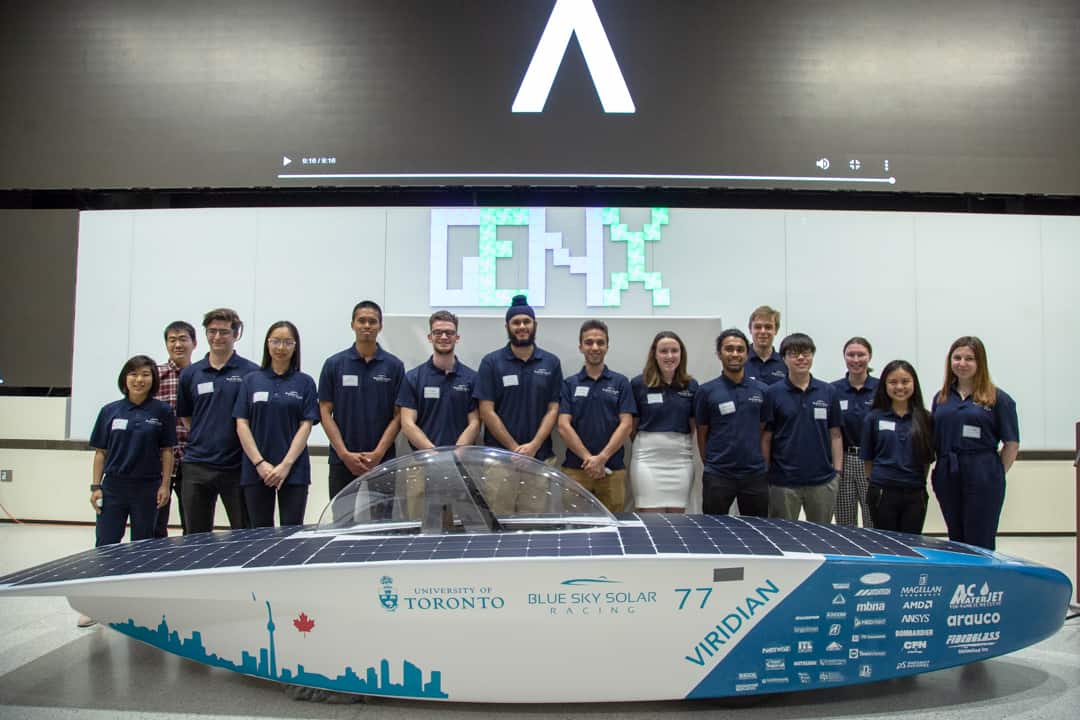A team of U of T Engineering undergraduate students named Blue Sky Solar Racing unveiled Viridian, the 10th generation of its solar-powered race car, in its first public unveiling event on June 24.
For over 22 years, different compositions of the team designed, built, and raced solar-powered cars, creating a new generation every two years.
This year, Blue Sky Solar Racing completed the design and manufacture of Generation X. The vehicle was showcased to the public for the first time at Myhal Centre Auditorium.
Race car’s manufacture celebrated by keynote speakers
The buzzing audience included team alumni, sponsors, and staff from the Faculty of Applied Science & Engineering. Around 200 guests attended in total.
Following an introduction by Managing Director Hubaab K. Hussain, two professors delivered remarks onstage.
Professor Amy Bilton, the Director of the Centre of Global Engineering, discussed her experiences as an alumna of Blue Sky Solar Racing. She reflected on her involvement as the Aerodynamics Team Lead in 2006, and noted that the team puts in an incredible amount of effort each year.
“[The team members] are basically doing more than a full-time job at the same time as they are doing a full load of engineering courses,” she said.
Professor Cristopher Yip, the Dean of the Faculty of Applied Science & Engineering, also spoke at the event, and congratulated the team on their successful manufacture of Generation X.
The unveiling of Viridian onstage
In a wave of applause, team members pulled back the curtain to reveal their feat of design.
Viridian is a boat-shaped solar-powered race car with a length of approximately three metres. The hood of the vehicle is covered with an array of solar panels. A glass hemisphere swells from the middle of the car, serving as the windshield.
In an interview with The Varsity, Hussain said that Viridian can reach a top speed of 120 kilometres per hour according to previous testing.
He said that the team continues to work on testing and characterizing the car — in addition to getting some much-needed sleep. This will be in preparation for racing Viridian in the international Bridgestone World Solar Challenge this autumn.
Racing 3000 kilometres in Australia
Viridian’s race will be the seventh time that the team’s vehicle will make the cross-continental trip from Darwin to Adelaide in Australia. Travelling north to south of the country, Viridian will race a course of 3000 kilometres.
The competition is set to begin in October. Before then, the team will repeatedly test the car to get as much characterized information about its performance as possible. Details such as its power consumption at certain speeds, as well as how certain environmental conditions affect Viridian’s performance, are especially valuable.
Potential commercial applications
Outside of racing competitions, solar-powered cars have an immense commercial potential. Hussain highlighted Lightyear, a start-up electric car manufacturer in the Netherlands.
The European company released their first solar-powered electric car on the same day as Blue Sky Solar Racing’s unveiling event. Its new car, named Lightyear One, is set to be released on the market soon, with a listed price of €149,000 in the Netherlands, roughly equivalent to 218,400 CAD.
In addition to developing solar-powered race cars, Hussain said that Blue Sky Solar Racing also aims to provide opportunities to enrich the experiences of undergraduates.
“The [goal] of the [Blue Sky Solar Racing],” said Hussain, “is to provide students with an opportunity to grow and develop outside of the classroom, as well as promote sustainable technology.”


